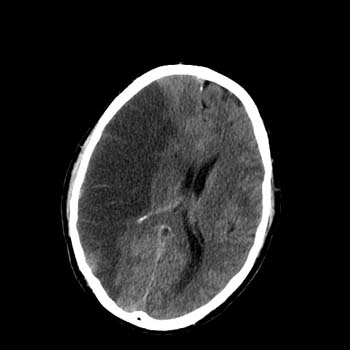Stroke and TIA

A stroke is a sudden onset of a neurological deficit (loss of strength, control, or sensation) due to a problem with the blood supply in the brain. The most common type of stroke is an ischemic stroke (CT image left). Ischemic means that the brain does not get enough blood. Think of it like a hose watering your lawn during a drought. If the hose gets blocked for a long enough time, the lawn will die. If an artery supplying blood to the brain gets blocked by a blood clot, then part of the brain will die for lack of blood. Unlike the lawn, the brain can only go for a short time, at most about 3 hours, without blood before it dies. Of course if the entire brain is not getting blood, it is only a matter of minutes before irreversible damage occurs. That is why if a person's heart stops, it is important to apply CPR or get it started again within minutes. Otherwise, the brain will become damaged.
The symptoms of an ischemic stroke, and the severity, depend on how large an artery is blocked and what part of the brain it supplies. Symptoms can be paralysis of one or more limbs, loss of sensation (numbness, tingling), loss of vision, loss of balance, or a number of other symptoms. The onset of the symptoms is sudden.
It is important to get the stroke patient to the emergency room immediately. This is because we now have "clot-buster" drugs that can dissolve the clot of they are given in the first 3 hours of a stroke, or sometimes even later, provided they are delivered directly onto the clot with a catheter. But the sooner the patient is treated the better. Time is brain. If you are present when a person demonstrates the sudden onset of the symptoms of a stroke, you should call 911 to have the person transported to the hospital.
 A hemorrhagic stroke (CT image left) occurs when blood leaks into the brain from a leak in a blood vessel. These strokes are also quite serious and patients with these must be treated in an ICU. High blood pressure is often a factor in causing these kinds of strokes. It requires trained specialists and equipment to determine which type of stroke a person has had. Since the treatment depends on the type of stroke, it is important that patients with stroke symptoms be transported to the hospital immediately.
A hemorrhagic stroke (CT image left) occurs when blood leaks into the brain from a leak in a blood vessel. These strokes are also quite serious and patients with these must be treated in an ICU. High blood pressure is often a factor in causing these kinds of strokes. It requires trained specialists and equipment to determine which type of stroke a person has had. Since the treatment depends on the type of stroke, it is important that patients with stroke symptoms be transported to the hospital immediately.
A TIA (or transient ischemic attack) occurs when an artery is blocked for a short period of time, not long enough for the brain cells downstream to die. The patient suffers the symptoms of a stroke, but they completely reverse without the damage of a stroke. TIAs are signs of impending stroke, and should be considered an emergency.
Useful Stroke Web Sites
Books
We have looked at these books and recommend them as useful sources of information. Links are included to the Amazon website where they also can often be obtained used at a very nominal price.
- Stroke (American Academy of Neurology)
, by Louis R. Caplan, MD.
- My Stroke of Insight: A Brain Scientist's Personal Journey
, by Jill Bolte Taylor, PhD.
- Living With Stroke: A Guide for Families
, by Richard C. Senelick, MD, and Karla Dougherty
- Stroke and the Family: A New Guide (Harvard University Press Family Health Guides)
, by Joel Stein, MD.